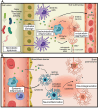Do Bacterial Outer Membrane Vesicles Contribute to Chronic Inflammation in Parkinson's Disease?
- PMID: 38427502
- PMCID: PMC10977405
- DOI: 10.3233/JPD-230315
Do Bacterial Outer Membrane Vesicles Contribute to Chronic Inflammation in Parkinson's Disease?
Abstract
Parkinson's disease (PD) is an increasingly common neurodegenerative disease. It has been suggested that the etiology of idiopathic PD is complex and multifactorial involving environmental contributions, such as viral or bacterial infections and microbial dysbiosis, in genetically predisposed individuals. With advances in our understanding of the gut-brain axis, there is increasing evidence that the intestinal microbiota and the mammalian immune system functionally interact. Recent findings suggest that a shift in the gut microbiome to a pro-inflammatory phenotype may play a role in PD onset and progression. While there are links between gut bacteria, inflammation, and PD, the bacterial products involved and how they traverse the gut lumen and distribute systemically to trigger inflammation are ill-defined. Mechanisms emerging in other research fields point to a role for small, inherently stable vesicles released by Gram-negative bacteria, called outer membrane vesicles in disease pathogenesis. These vesicles facilitate communication between bacteria and the host and can shuttle bacterial toxins and virulence factors around the body to elicit an immune response in local and distant organs. In this perspective article, we hypothesize a role for bacterial outer membrane vesicles in PD pathogenesis. We present evidence suggesting that these outer membrane vesicles specifically from Gram-negative bacteria could potentially contribute to PD by traversing the gut lumen to trigger local, systemic, and neuroinflammation. This perspective aims to facilitate a discussion on outer membrane vesicles in PD and encourage research in the area, with the goal of developing strategies for the prevention and treatment of the disease.
Keywords: Extracellular vesicles; Parkinson’s disease; bacteria; bacterial outer membrane vesicles; endotoxin; inflammation; innate immune response; lipopolysaccharide; membrane particles; microbiota-gut-brain axis; spread.
Conflict of interest statement
The authors have no conflicts of interest to report.
Figures

Similar articles
-
Fecal microbiota transplantation protects rotenone-induced Parkinson's disease mice via suppressing inflammation mediated by the lipopolysaccharide-TLR4 signaling pathway through the microbiota-gut-brain axis.Microbiome. 2021 Nov 17;9(1):226. doi: 10.1186/s40168-021-01107-9. Microbiome. 2021. PMID: 34784980 Free PMC article.
-
Microbiome-Gut-Brain Axis and Toll-Like Receptors in Parkinson's Disease.Int J Mol Sci. 2018 Jun 6;19(6):1689. doi: 10.3390/ijms19061689. Int J Mol Sci. 2018. PMID: 29882798 Free PMC article. Review.
-
Chronic stress-induced gut dysfunction exacerbates Parkinson's disease phenotype and pathology in a rotenone-induced mouse model of Parkinson's disease.Neurobiol Dis. 2020 Feb;135:104352. doi: 10.1016/j.nbd.2018.12.012. Epub 2018 Dec 21. Neurobiol Dis. 2020. PMID: 30579705 Review.
-
Oral and intestinal dysbiosis in Parkinson's disease.Rev Neurol (Paris). 2023 Nov;179(9):937-946. doi: 10.1016/j.neurol.2022.12.010. Epub 2023 Mar 16. Rev Neurol (Paris). 2023. PMID: 36934020 Review.
-
Unravelling the role of gut microbiota in Parkinson's disease progression: Pathogenic and therapeutic implications.Neurosci Res. 2021 Jul;168:100-112. doi: 10.1016/j.neures.2021.01.001. Epub 2021 Jan 5. Neurosci Res. 2021. PMID: 33417973 Review.
Cited by
-
Infections in the Etiology of Parkinson's Disease and Synucleinopathies: A Renewed Perspective, Mechanistic Insights, and Therapeutic Implications.J Parkinsons Dis. 2024;14(7):1301-1329. doi: 10.3233/JPD-240195. J Parkinsons Dis. 2024. PMID: 39331109 Free PMC article. Review.
-
Gut Microbiota and Bacterial Extracellular Vesicles: Emerging Roles in Myocardial Remodelling and Cardiac Health.J Extracell Biol. 2025 Aug 11;4(8):e70079. doi: 10.1002/jex2.70079. eCollection 2025 Aug. J Extracell Biol. 2025. PMID: 40791567 Free PMC article. Review.
-
Psychobiotics and the Microbiota-Gut-Brain Axis: Where Do We Go from Here?Microorganisms. 2024 Mar 22;12(4):634. doi: 10.3390/microorganisms12040634. Microorganisms. 2024. PMID: 38674579 Free PMC article. Review.
References
-
- Kalia LV, Lang AE (2015) Parkinson’s disease. Lancet 386, 896–912. - PubMed
-
- Kieburtz K, Wunderle KB (2013) Parkinson’s disease: Evidence for environmental risk factors. Mov Disord 28, 8–13. - PubMed
-
- Ascherio A, Schwarzschild MA (2016) The epidemiology of Parkinson’s disease: Risk factors and prevention. Lancet Neurol 15, 1257–1272. - PubMed
Publication types
MeSH terms
LinkOut - more resources
Full Text Sources
Medical

